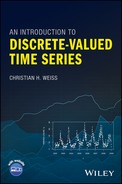Preface
People have long been interested in time series: data observed sequentially in time. See Klein (1997) for a historical overview. Nowadays, such time series are collected in diverse fields of science and practice, such as business, computer science, epidemiology, finance, manufacturing or meteorology. In line with the increasing potential for applications, more and more textbooks on time series analysis have become available; see for example the recent ones by Box et al. (2015), Brockwell & Davis (2016), Cryer & Chan (2008), Falk et al. (2012), Shumway & Stoffer (2011) and Wei (2006). These textbooks nearly exclusively concentrate on continuous-valued time series, where real numbers or vectors are the possible outcomes. During the last few decades, however, discrete-valued time series have also become increasingly important in research and applications. These are time series arising from counting certain objects or events at specified times, but they are usually neglected in the textbook literature. Among the few introductory or overview texts on discrete-valued time series are
- the books (or parts thereof) by Fahrmeir & Tutz (2001), Kedem & Fokianos (2002) and Cameron & Trivedi (2013) about regression models
- the book by Zucchini & MacDonald (2009) about hidden-Markov models
- the survey article by McKenzie (2003) in the Handbook of Statistics
- the textbook by Turkman et al. (2014), which includes a chapter about models for integer-valued time series
- the book by Davis et al. (2016), which provides a collection of essays about discrete-valued time series.
The present book intends to be an introductory text to the field of discrete-valued time series, and to present the subject with a good balance between theory and application. It covers common models for time series of counts as well as for categorical time series, and it works out their most important stochastic properties. It provides statistical approaches for analyzing discrete-valued time series, and it exemplifies their practical implementation in a number of data examples. It does not constitute a purely mathematical treatment of the considered topics, but tries to be accessible to users from all those areas where discrete-valued time series arise and need to be analyzed. Inspired by the seminal time series book by Box & Jenkins (1970), there is a strong emphasis on models and methods “possessing maximum simplicity”, but it also provides background and references on more sophisticated approaches. Furthermore, following again the example of Box & Jenkins, the book also includes a part on methods from statistical process control, for the monitoring of a discrete-valued process.
The book is aimed at academics at graduate level having a basic knowledge of mathematics (calculus, linear algebra) and statistics. In addition, elementary facts about time series and stochastic processes are assumed, as they are typically taught in basic courses on time series analysis (also see the textbooks listed above on time series analysis). To allow the reader to refresh their knowledge and to make this book more self-contained, Appendix B contains background information on, for example, Markov chains and ARMA models. Besides putting the reader in a position to analyze and model the discrete-valued time series occurring in practice, the book can also be used as a textbook for a lecture on this topic. The author has already used parts of the book in courses about discrete-valued time series. To support both its application in practice and its use in teaching, ready-made software implementations for the data examples and numerical examples are available to accompany the book. Although such implementations are generally not restricted to a particular software package, the program codes are written in the R language (R Core Team, 2016), since R is freely available to everyone. But each of the examples in this book could have been done with another computational software like Matlab or Mathematica as well. All the R codes, and most of the datasets, are provided on a companion website, see Appendix C for details.
I am very grateful to Prof. Dr. Konstantinos Fokianos (University of Cyprus), Prof. Dr. Robert Jung (University of Hohenheim), Prof. Dr. Dimitris Karlis (Athens University of Economics and Business) and to M. Sc. Tobias Möller (Helmut Schmidt University Hamburg) for reading the entire manuscript and for many valuable comments. I also wish to thank Prof. Dr. Sven Knoth (Helmut Schmidt University Hamburg) for useful feedback on Part III of this book, as well as M. Sc. Boris Aleksandrov and M. Sc. Sebastian Ottenstreuer (ibid.) for making me aware of some typographical errors. I want to thank Prof. Dr. Kurt Brännäs (Umeå University) for allowing me to share the transactions counts data in Example 4.1.5, Alexander Jonen (Helmut Schmidt University Hamburg) for making me aware of the rig counts data in Example 2.6.2, and again Prof. Dr. Dimitris Karlis for contributing the accidents counts data in Example 3.4.2. Thanks go to the Helmut Schmidt University in Hamburg, to the editorial staff of Wiley, especially to Blesy Regulas and Shyamala Venkateswaran for the production of this book, and to Andrew Montford (Anglosphere Editing Limited) for the copyediting of the book. Finally, I wish to thank my wife Miia and my children Maximilian, Tilman and Amalia for their encouragement and welcome distraction during this work.
Christian H. Weiss
Hamburg
February 2017
